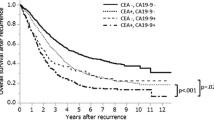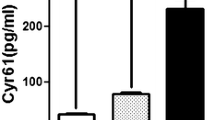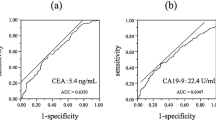Abstract
Purpose
Among diverse tumor markers, pretreatment evaluation and follow-up detection of recurrence in colorectal cancer are generally evaluated by serum carcinoembryonic antigen (CEA) levels. However, there have been some reports about the low accuracy and high false-positive results of CEA in colorectal cancer. We investigated the clinical utilities of CYFRA 21–1 by comparing CEA and cancer antigen 19–9 (CA 19–9) in pretreatment and recurrent colorectal cancer.
Methods
Using a solid-phase immunoradiometric assay, serum levels of CYFRA 21–1, CEA and CA 19–9 were analyzed in 132 patients with primary colorectal cancer, 124 healthy controls, 104 patients with benign colorectal disease and 19 patients with recurrent colorectal cancer. We determined three different cutoff values to evaluate the sensitivity of diagnostic performance in pretreatment and recurrent colorectal cancer.
Results
CYFRA 21–1 (≥ 1.13 ng/ml) had a sensitivity of 47 %, compared with 37 % for CEA (≥ 3.05 ng/ml) and 32.6 % for CA 19–9 (≥ 23.1 ng/ml) in the initial staging of primary colorectal cancer. Using different cutoff values, CYFRA 21–1 showed higher sensitivity for pretreatment colorectal cancer than CEA and CA 19–9 in adenocarcinoma and adenosquamous carcinoma of this study. A mildly significant correlative relationship was noted between Dukes’ stages and three tumor markers (p < 0.01). The areas under the receiver operating characteristic curves of CYFRA 21–1, CEA and CA 19–9 were 0.81 ± 0.03, 0.74 ± 0.03 and 0.62 ± 0.04, respectively, for discriminating colorectal cancer patients from patients with benign colorectal disease. In addition, CYFRA 21–1 was determined as the most sensitive tumor marker for evaluating recurrent colorectal cancer for all cutoff values.
Conclusion
This study showed that CYFRA 21–1 could be a useful and dependable tumor marker for pretreatment and recurrent colorectal cancer. Further prospective studies on its usefulness with respect to the prognosis and utility of combined tumor markers are needed.


Similar content being viewed by others
References
Reya T, Clevers H. Wnt signalling in stem cells and cancer. Nature. 2005;434:843–50.
Sarikaya I, Bloomston M, Povoski SP, Zhang J, Hall NC, Knopp MV, et al. FDG-PET scan in patients with clinically and/or radiologically suspicious colorectal cancer recurrence but normal CEA. World J Surg Oncol. 2007;5:64.
Fiocchi F, Iotti V, Ligabue G, Malavasi N, Luppi G, Bagni B, et al. Role of carcinoembryonic antigen, magnetic resonance imaging, and positron emission tomography-computed tomography in the evaluation of patients with suspected local recurrence of colorectal cancer. Clin Imaging. 2011;35:266–73.
Lee JH, Park SG, Jee KN, Park DG, Namgung H, Song IH. Performance of FDG PET/CT in postoperative colorectal cancer patients with a suspected recurrence and a normal CEA level. Nucl Med Commun. 2010;31:576–82.
Riedl CC, Akhurst T, Larson S, Stanziale SF, Tuorto S, Bhargava A, et al. 18F-FDG PET scanning correlates with tissue markers of poor prognosis and predicts mortality for patients after liver resection for colorectal metastases. J Nucl Med. 2007;48:771–5.
Sanli Y, Kuyumcu S, Ozkan ZG, Kilic L, Balik E, Turkmen C, et al. The utility of FDG-PET/CT as an effective tool for detecting recurrent colorectal cancer regardless of serum CEA levels. Ann Nucl Med. 2012;56:551–8.
Chang AC, Warren LR, Barreto SG, Williams R. Differing serum cea in primary and recurrent rectal cancer—a reflection of histology? World J Oncol. 2012;3:59–63.
Waisberg J, Contim-Neto L, Oliveira MSL, Matheus CO, Nagashima CA, Goffi FS. Determination of carcinoembryonic antigen levels in peripheral and draining venous blood in patients with colorectal carcinoma. Arq Gastroenterol. 2004;41:88–92.
Booth S, King J, Leonard J, Dykes P. Serum carcinoembryonic antigen in clinical disorders. Gut. 1973;14:794–9.
Loewenstein M, Zamcheck N. Carcinoembryonic antigen (CEA) levels in benign gastrointestinal disease states. Cancer. 1978;42:1412–8.
Van der Schouw YT, Verbeek AL, Wobbes T, Segers MF, Thomas CM. Comparison of four serum tumour markers in the diagnosis of colorectal carcinoma. Br J Cancer. 1992;66:148–54.
Chapman MH, Sandanayake NS, Andreola F, Dhar DK, Webster GJ, Dooley JS, et al. Circulating CYFRA 21–1 is a specific diagnostic and prognostic biomarker in biliary tract cancer. J Clin Exp Hepatol. 2011;1:6–12.
Verwaal V, Zoetmulder F. Follow-up of patients treated by cytoreduction and chemotherapy for peritoneal carcinomatosis of colorectal origin. Eur J Surg Oncol. 2004;30:280–5.
Yang SH, Lin JK, Lai CR, Chen CC, Li A, Liang WY, et al. Risk factors for peritoneal dissemination of colorectal cancer. J Surg Oncol. 2004;87:167–73.
Zheng CX, Zhan WH, Zhao JZ, Zheng D, Wang DP, He YL, et al. The prognostic value of preoperative serum levels of CEA, CA19-9 and CA72-4 in patients with colorectal cancer. World J Gastroenterol. 2001;7:431–4.
Kantoush AA, Ahmed MM, Bushra SS. Evaluation of cyfra 21–1 as a diagnostic tool in lung cancer. J Appl Sci Res. 2009;5:1195–201.
Lumachi F, Marino F, Orlando R, Chiara GB, Basso SMM. Simultaneous multianalyte immunoassay measurement of five serum tumor markers in the detection of colorectal cancer. Anticancer Res. 2012;32:985–8.
Giovanella L, Ceriani L, Giardina G, Bardelli D, Tanzi F, Garancini S. Serum cytokeratin fragment 21.1 (CYFRA 21.1) as tumour marker for breast cancer: comparison with carbohydrate antigen 15.3 (CA 15.3) and carcinoembryonic antigen (CEA). Clin Chem Lab Med. 2002;40:298–303.
Brechot J, Chevret S, Nataf J, Le Gall C, Fretault J, Rochemaure J, et al. Diagnostic and prognostic value of cyfra 21–1 compared with other tumour markers in patients with non-small cell lung cancer: a prospective study of 116 patients. Eur J Cancer. 1997;33:385–91.
Molina R, Filella X, Auge J, Fuentes R, Bover I, Rifa J, et al. Tumor markers (CEA, CA 125, CYFRA 21–1, SCC and NSE) in patients with non-small cell lung cancer as an aid in histological diagnosis and prognosis. Tumor Biol. 2003;24:209–18.
Molina R, Filella X, Augé JM, Bosch E, Torne A, Pahisa J, et al. CYFRA 21.1 in patients with cervical cancer: comparison with SCC and CEA. Anticancer Res. 2005;25:1765–71.
Jeong S, Park Y, Cho Y, Kim YR, Kim HS. Diagnostic values of urine CYFRA21-1, NMP22, UBC, and FDP for the detection of bladder cancer. Clin Chim Acta. 2012;414:93–100.
Kulpa J, Wójcik E, Reinfuss M, Kołodziejski L. Carcinoembryonic antigen, squamous cell carcinoma antigen, CYFRA 21–1, and neuron-specific enolase in squamous cell lung cancer patients. Clin Chem. 2002;48:1931–7.
Maass J, Hoffmann-Fazel A, Goeroegh T, Hoffmann M, Meyer J, Gottschlich S, et al. Cyfra 21–1: a serological help for detection of distant metastases in head and neck cancer. Anticancer Res. 2000;20:2241–4.
Labianca R, Nordlinger B, Beretta G, Brouquet A, Cervantes A. Primary colon cancer: ESMO clinical practice guidelines for diagnosis, adjuvant treatment and follow-up. Ann Oncol. 2010;21:v70–7.
Scott NA, Wieand HS, Moertel CG, Cha SS, Beart RW, Lieber MM. Colorectal cancer: Dukes’ stage, tumor site, preoperative plasma CEA level, and patient prognosis related to tumor DNA ploidy pattern. Arch Surg. 1987;122:1375–9.
Goldstein MJ, Mitchell EP. Carcinoembryonic antigen in the staging and follow-up of patients with colorectal cancer. Cancer Investig. 2005;23:338–51.
Sheard MA, Vojtesek B, Simickova M, Valik D. Release of cytokeratin-18 and −19 fragments (TPS and CYFRA 21–1) into the extracellular space during apoptosis. J Cell Biochem. 2002;85:670–7.
Takada M, Masuda N, Matsuura E, Kusunoki Y, Matui K, Nakagawa K, et al. Measurement of cytokeratin 19 fragments as a marker of lung cancer by CYFRA 21–1 enzyme immunoassay. Br J Cancer. 1995;71:160–5.
Brockmann JG, Nottberg HS, Glodny B, Heinecke A, Senninger NJ. CYFRA 21–1 serum analysis in patients with esophageal cancer. Clin Cancer Res. 2000;6:4249–52.
Xu D, Li X, Zheng S, Jiang W. Quantitative real-time RT-PCR detection for CEA, CK20 and CK19 mRNA in peripheral blood of colorectal cancer patients. J Zhejiang Univ Sci B. 2006;7:445–51.
Holdenrieder S, Stieber P, Liska V, Treska V, Topolcan O, Dreslerova J, et al. Cytokeratin serum biomarkers in patients with colorectal cancer. Anticancer Res. 2012;32:1971–6.
Wild N, Andres H, Rollinger W, Krause F, Dilba P, Tacke M, et al. A combination of serum markers for the early detection of colorectal cancer. Clin Cancer Res. 2010;16:6111–21.
Uenishi T, Kubo S, Hirohashi K, Tanaka H, Shuto T, Yamamoto T, et al. Cytokeratin-19 fragments in serum (CYFRA 21–1) as a marker in primary liver cancer. Br J Cancer. 2003;88:1894–9.
Kim DW, Kim WH, Kim CG. Dual-time-point FDG PET/CT: is it useful for lymph node staging in patients with non-small-cell lung cancer? Nucl Med Mol Imaging. 2012;46:196–200.
Jeong SY, Lee TH, Rhee CH, Cho AR, Kim BI, Cheon GJ, et al. 3′-Deoxy-3′-[18F]fluorothymidine and O-(2-[18F]fluoroethyl)-L-tyrosine PET in patients with suspicious recurrence of glioma after multimodal treatment: initial results of a retrospective comparative study. Nucl Med Mol Imaging. 2010;44:45–54.
Acknowledgments
The present research was conducted by the research fund of Dankook University in 2012.
Conflicts of Interest
None.
Author information
Authors and Affiliations
Corresponding author
Rights and permissions
About this article
Cite this article
Lee, J.H. Clinical Usefulness of Serum CYFRA 21–1 in Patients with Colorectal Cancer. Nucl Med Mol Imaging 47, 181–187 (2013). https://doi.org/10.1007/s13139-013-0218-4
Received:
Revised:
Accepted:
Published:
Issue Date:
DOI: https://doi.org/10.1007/s13139-013-0218-4




